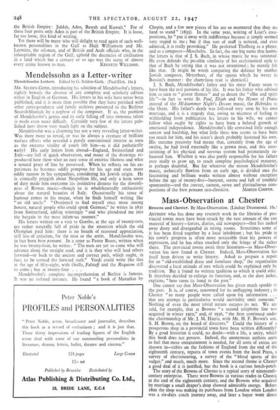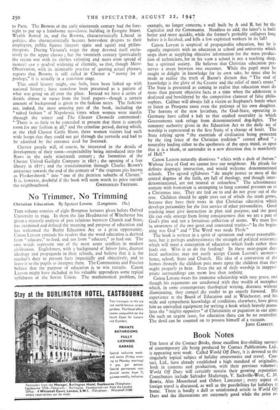Mass-Observation at Chester
Browns and Chester. By Mass-Observation. (Lindsay Drummond. 15s.)
ANYBODY who has done any research work in the libraries of pro- vincial towns must have been struck by the vast amount of the raw material of history—letters, diaries, old newspapers—that lies tucked away dusty and disregarded in strong rooms. Sometimes some of it has been fitted together by a local inhabitant ; but his pride in his town's progress is often more noticeable than his powers of expression, and he has often touched only the fringe of the riches there. The provincial towns await their historians—as Mass-Obser- vation has now found at Chester. Indeed, Mass-Observation has itself been driven to write history. Asked to prepare a report for an " old-established dress and furniture shop," the organisation discovered a local attitude of awe which could be explained only by tradition. But it found no written tradition to which it could refer. It therefore decided to enlarge its function, and, as the dust jacket, explains, " here turns its hand to the past."
One cannot say that Mass-Observation has given much sparkle to the past. It is, of course, renowned for its unflagging industry ; in Chester " so many people were called upon for information . . . that any attempt to particularise would inevitably omit someone." Nothing of even the most trivial nature escapes its net. We are told, for example, that at Browns " a second telephone line was acquired in winter 191o," and, of 1936, " the firm continued under the chairmanship of Mr. J. M. Harris, with Mr. H. F. Brown's son, S. H. Brown, on the board of directors." Could the history of a prosperous shop in a provincial town have been written differently? By a good historian it could, no doubt—with a life, a unity, which this book does not possess. .Indeed, the anonymous authors seem to feel that more entertainment is needed, for all sorts of extras are thrown in—titbits on the fashions of England from the end of the eighteenth century, reports of town events from the local Press, a survey of electioneering, a survey of the " blood sports of the vulgar," and much, much more. Since the second theme is Chester a good deal of it is justified, but the book is a curious hotch-potch.
The story of the Browns of Chester is a typical story of nineteenth- century enterprise. There were Browns in various trades in Chester at the end of the eighteenth century, and the Browns who acquired by marriage a small draper's shop showed admirable energy. Before 1800 the shop was making its purchases from London when London was a six-days coach journey away, and later a buyer went direct to Parts. The Browns of the early nineteenth century had the fore- sight to put up a handsome neo-classic building in Eastgate Street. Wealth flowed in, and the Browns, characteristically Liberal in politics, also characteristically became benevolent despots to their employees, public figures (mayors again and again) and philan- thropists. During Victoria's reign the shop devoted itself exclu- sively to the upper classes ; but the twentieth century (particularly the recent war with its clothes rationing and more even spread of money) saw a gradual widening of clientele, so that, though Mass- Observation, with its inimitable practice of quoting actual phrases, reports that Browns is still called in Chester a " snooty lot of posheas," it is actually in a transition stage.
This small history might, one feels, have been linked up with national history ; have somehow been presented as a pattern of what was going on all over the place. Instead we have a series of details almost in vacuo from the local papers—though a certain amount of background is given to the fashion notes. The fashions are, indeed, the most amusing part of the book, including the " naked fashion " of Napoleonic times when women wore muslin through the winter and The Chester Chronicle commented : " There is so little to be concealed at present that there is scarcely room for any fashion at all," and the crinoline period, during which, at the 1858 Chester Cattle Show, three women visitors had such wide hoops that they could not get through the turnstile and had to be admitted by the entrance used for livestock.
Chester people will, of course, be interested in the details of development of their town—respectability being introduced into the Rows in -the early nineteenth century ; the formation of the Chester United Gaslight Company in 1817 ; the opening of a free library in 1877 ; and the transformation through Charles Brown's insistence towards the end of the century of " the stagnant pits known as Flookersbrook " into " one of the prettiest suburbs of Chester." It is, however, doubtful if the book will seem worth its price outside



































 Previous page
Previous page